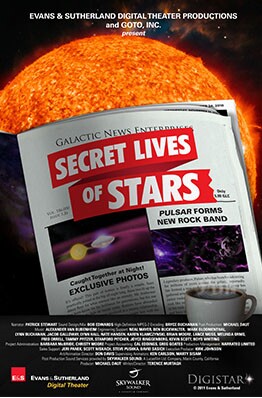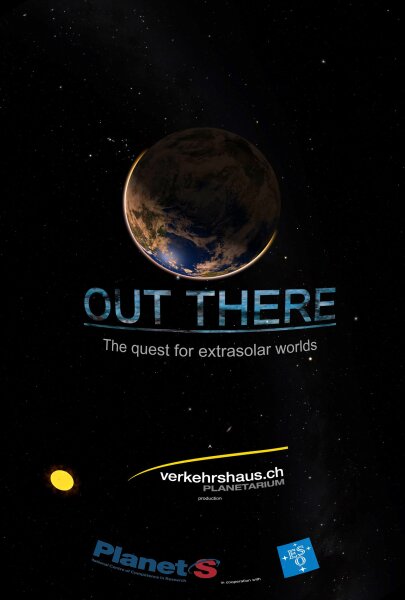Royden G. Derrick Planetarium

The Royden G. Derrick planetarium was completed in March of 2005, and upgraded in Aug. 2010 and again in 2021. The facility is located on the 4th floor of the Eyring Science Center on the BYU campus in Provo, Utah and is used primarily for holding university classes. However, we also provide outreach shows for community groups as well as shows for the general public.

Secret Lives of Stars

Herbig-Haro 46/47 (NIRCam image)
The NASA/ESA/CSA James Webb Space Telescope has captured a high-resolution image of a tightly bound pair of actively forming stars, known as Herbig-Haro 46/47, in near-infrared light. Look for them at the centre of the red diffraction spikes. The stars are buried deeply, appearing as an orange-white splotch. They are surrounded by a disc of gas and dust that continues to add to their mass. Herbig-Haro 46/47 is an important object to study because it is relatively young — only a few thousand years old. Stars take millions of years to form. Targets like this also give researchers insight into how stars gather mass over time, potentially allowing them to model how our own Sun, a low-mass star, formed. The two-sided orange lobes were created by earlier ejections from these stars. The stars’ more recent ejections appear as blue, thread-like features, running along the angled diffraction spike that covers the orange lobes. Actively forming stars ingest the gas and dust that immediately surrounds them in a disc (imagine an edge-on circle encasing them). When the stars ‘eat’ too much material in too short a time, they respond by sending out two-sided jets along the opposite axis, settling down the star’s spin, and removing mass from the area. Over millennia, these ejections regulate how much mass the stars retain. Don’t miss the delicate, semi-transparent blue cloud. This is a region of dense dust and gas, known as a nebula. Webb’s crisp near-infrared image lets us see through its gauzy layers, showing off a lot more of Herbig-Haro 46/47, while also revealing a wide range of stars and galaxies that lie far beyond it. The nebula’s edges transform into a soft orange outline, like a backward L along the right and bottom of the image. The blue nebula influences the shapes of the orange jets shot out by the central stars. As ejected material rams into the nebula on the lower left, it takes on wider shapes, because there is more opportunity for the jets to interac
Space Telescope Science Institut

Out There poster

Webb’s View of the Molecular Cloud Chameleon I
This image by the NASA/ESA/CSA James Webb Space Telescope’s Near-InfraRed Camera (NIRCam) features the central region of the Chameleon I dark molecular cloud, which resides 630 light years away. The cold, wispy cloud material (blue, centre) is illuminated in the infrared by the glow of the young, outflowing protostar Ced 110 IRS 4 (orange, upper left). The light from numerous background stars, seen as orange dots behind the cloud, can be used to detect ices in the cloud, which absorb the starlight passing through them. An international team of astronomers has reported the discovery of diverse ices in the darkest, coldest regions of a molecular cloud measured to date by studying this region. This result allows astronomers to examine the simple icy molecules that will be incorporated into future exoplanets, while opening a new window on the origin of more complex molecules that are the first step in the creation of the building blocks of life. [Image Description: A large, dark cloud is contained within the frame. In its top half it is textured like smoke and has wispy gaps, while at the bottom and at the sides it fades gradually out of view. On the left are several orange stars: three each with six large spikes, and one behind the cloud which colours it pale blue and orange. Many tiny stars are visible, and the background is black.]
NASA, ESA, CSA, and M. Zamani (E

Southern Ring Nebula (NIRCam and MIRI Images Side by Side)
This side-by-side comparison shows observations of the Southern Ring Nebula in near-infrared light, at left, and mid-infrared light, at right, from the NASA/ESA/CSA Webb Telescope. This scene was created by a white dwarf star — the remnant of a star like our Sun after it shed its outer layers and stopped burning fuel through nuclear fusion. Those outer layers now form the ejected shells seen in this view. In the Near-Infrared Camera (NIRCam) image, the white dwarf appears to the lower left of the bright, central star, partially hidden by a diffraction spike. The same star appears — but brighter, larger, and redder — in the Mid-Infrared Instrument (MIRI) image. This white dwarf star is cloaked in thick layers of dust, which make it appear larger. The brighter star in both images hasn’t yet shed its layers. It closely orbits the dimmer white dwarf, helping to distribute what it’s ejected. Over thousands of years and before it became a white dwarf, the star periodically ejected mass — the visible shells of material. As if on repeat, it contracted, heated up, and then, unable to push out more material, pulsated. Stellar material was sent in all directions — like a rotating sprinkler — and provided the ingredients for this asymmetrical landscape. Today, the white dwarf is heating up the gas in the inner regions — which appear blue in the left-hand image and red in the right-hand image. Both stars are lighting up the outer regions, shown in orange and blue, respectively. The images look very different because NIRCam and MIRI collect different wavelengths of light. NIRCam observes near-infrared light, which is closer to the visible wavelengths our eyes detect. MIRI goes farther into the infrared, picking up mid-infrared wavelengths. The second star appears more clearly in the MIRI image, because this instrument can see the gleaming dust around it, bringing it more clearly into view. The stars — and their layers of light — steal more attention in the N
Space Telescope Science Institut

Carina Nebula Jets (NIRCam Narrowband Filters)
Scientists taking a “deep dive” into one of the iconic first images from the NASA/ESA/CSA James Webb Space Telescope have discovered dozens of energetic jets and outflows from young stars previously hidden by dust clouds. The discovery marks the beginning of a new era of investigating how stars like our Sun form, and how the radiation from nearby massive stars might affect the development of planets. Dozens of previously hidden jets and outflows from young stars are revealed in this new image from Webb’s Near-Infrared Camera (NIRCam). This image separates out several wavelengths of light from the First Image revealed on 12 July 2022, which highlights molecular hydrogen, a vital ingredient for star formation. The Cosmic Cliffs, a region at the edge of a gigantic, gaseous cavity within the star cluster NGC 3324, has long intrigued astronomers as a hotbed for star formation. While well-studied by the NASA/ESA Hubble Space Telescope, many details of star formation in NGC 3324 remain hidden at visible-light wavelengths. Webb is perfectly primed to tease out these long-sought-after details since it is built to detect jets and outflows seen only in the infrared at high resolution. Webb’s capabilities also allow researchers to track the movement of other features previously captured by Hubble. Recently, by analyzing data from a specific wavelength of infrared light (4.7 microns), astronomers discovered two dozen previously unknown outflows from extremely young stars revealed by molecular hydrogen. Webb’s observations uncovered a gallery of objects ranging from small fountains to burbling behemoths that extend light-years from the forming stars. Many of these protostars are poised to become low mass stars, like our Sun. Molecular hydrogen is a vital ingredient for making new stars and an excellent tracer of the early stages of their formation. As young stars gather material from the gas and dust that surround them, most also eject a fraction of that material back
Space Telescope Science Institut

Annular Ring of Fire Eclipse
This photograph of an annular solar eclipse was taken on May 20, 2012.
Credit: NASA/Bill Dunford

JWT-images/7f6tPx25BguUuLFKzauPiT-970-80.jpg

Pillars of Creation (NIRCam and MIRI Composite Image)
By combining images of the iconic Pillars of Creation from two cameras aboard the NASA/ESA/CSA James Webb Space Telescope, the Universe has been framed in its infrared glory. Webb’s near-infrared image was fused with its mid-infrared image, setting this star-forming region ablaze with new details. Myriad stars are spread throughout the scene. The stars primarily show up in near-infrared light, marking a contribution of Webb’s Near-Infrared Camera (NIRCam). Near-infrared light also reveals thousands of newly formed stars – look for bright orange spheres that lie just outside the dusty pillars. In mid-infrared light, the dust is on full display. The contributions from Webb’s Mid-Infrared Instrument (MIRI) are most apparent in the layers of diffuse, orange dust that drape the top of the image, relaxing into a V. The densest regions of dust are cast in deep indigo hues, obscuring our view of the activities inside the dense pillars. Dust also makes up the spire-like pillars that extend from the bottom left to the top right. This is one of the reasons why the region is overflowing with stars – dust is a major ingredient of star formation. When knots of gas and dust with sufficient mass form in the pillars, they begin to collapse under their own gravitational attraction, slowly heat up, and eventually form new stars. Newly formed stars are especially apparent at the edges of the top two pillars – they are practically bursting onto the scene. At the top edge of the second pillar, undulating detail in red hints at even more embedded stars. These are even younger, and are quite active as they form. The lava-like regions capture their periodic ejections. As stars form, they periodically send out supersonic jets that can interact within clouds of material, like these thick pillars of gas and dust. These young stars are estimated to be only a few hundred thousand years old, and will continue to form for millions of years. Almost everything you see in this scene is lo
Space Telescope Science Institut

